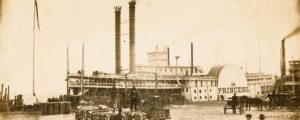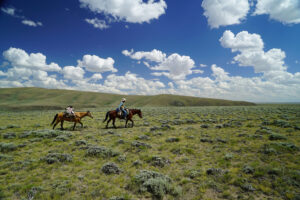Wootton was a shrewd entrepreneur.
Even Dick Wootton’s two hunting dogs didn’t want any part of the rabid wolf that had fearlessly entered the trapper’s camp. After Wootton stood up and encouraged the dogs, they went for the wolf, but they were no match for it. In no time, the wolf broke away and went for Wootton. He picked up a club and struck the mad beast, stunning it for a moment while breaking the club. Then the wolf sprang at Wootton’s throat, and he quickly drew his hunting knife.
“I managed to drive it into his side, catching him at the same time by the back of his neck with the other hand and flinging him away from me,” recalled Wootton, who had 50 years of adventure on the frontier. “The knife thrust killed him and I escaped without being bitten or scratched, although it was just by the skin of my teeth. The adventure cost me two fine hunting dogs.”
Besides fighting a rabid wolf, Wootton also had run-ins with Indians and Mexicans. He earned the nickname “Uncle Dick” one holiday evening in Taos, New Mexico Territory, when he provided a merry, celebrating crowd with two free kegs of Taos Lightning. At various times in his life (1816-93), the old trapper was a mule skinner, buffalo hunter, Indian trader, military guide, rancher, storekeeper and farmer. His most notable achievement was building a passable road where the Santa Fe Trail crossed over Raton Pass into New Mexico Territory. Like most everything else he did, he built the road to make money. His adventures may have been exaggerated during his long life, but he indeed proved to be a shrewd entrepreneur.
Born in Mecklenburg County, Va., Richens Lacy Wootton made stops in Kentucky and Mississippi before, at age 20, he ventured to Independence, Mo., and hired on with a Bent, St. Vrain and Company wagon train bound for Bent’s Fort in what would become Colorado. During that trip he had his first brush with Indians, shot a lead mule he mistook for an Indian, and also killed his first buffalo. In the months that followed, he traded with Sioux and Pawnees and sometimes fought with them and other Indians. In 1838 he joined a two-year fur trapping expedition in which he and his companions crossed the Rockies to trade and trap in the Far West before heading back to Bent’s Fort through future Arizona.
Near what became Pueblo, Colo., he established a ranch while also continuing to trade with various Indian parties, including Utes and Comanches. During the Mexican War, Wootton served as a guide and scout during Colonel A.W. Doniphan’s march into Mexico. When the army met resistance near Chihuahua, he brought dispatches back to headquarters in Santa Fe. In 1848 he served as a guide again, this time in a campaign against the Navajos, and his home base became Taos.
In 1852 he heard that the gold miners in California would pay plenty for decent food. Thus persuaded, Wootton, along with 14 experienced Mexican herders and eight well-armed American guards, drove a flock of 8,000 sheep from Taos to Sacramento. Along the way he sold some mutton to the Mormons and visited with their leader, Brigham Young. On the return trip, he almost died of thirst while crossing Death Valley, but he made it home with a healthy profit.
At age 42, in the late 1850s, he entertained thoughts of going back to the States, where he said there were “fewer hardships and privations to undergo,” and he could visit old friends and relatives. Once in the boom camp of Denver, though, his plans changed. He found he could make a profit selling goods to the folks who had come to the Cherry Creek area in search of gold, so he built a store. Profits were good, but he tired of being a storekeeper and went back to farming and ranching in the Pueblo area in 1861. Believing that buffalo were stronger than oxen, he domesticated some of the shaggy beasts but did not start a trend.
In the mid-’60s, Wootton began a more satisfying project—building his road. Noting that wagon train parties and army troops on the Mountain Branch of the Santa Fe Trail struggled as they crossed the rugged terrain between Colorado and New Mexico Territory, he went to the Colorado Legislature and received an official charter. “I had long had in mind the building of a state road through Raton Pass,” he said in the 1890 book “Uncle Dick” Wootton, by H.L. Conard, “and thought it was a good time to put through my project…a natural highway and destined to be a thoroughfare for the settlements which would spring up.” He was allowed to put up a tollgate, which not only paid for the project but also allowed for plenty of profits. For some of the actual roadwork he hired Ute Indians under Chief Conniach. “I had undertaken no slight task,” he recalled. “There were hillsides to cut down, rocks to blast and remove, and bridges to build by the score. I built the road, however, and made it a good one, too. My twenty-seven miles of turnpike constituted a portion of an international thoroughfare.”
Most historians say that the project was completed in 1866, but there is a record of passage on the improved road over Raton Pass in 1865. Wagons, coaches and buggies paid $1.50, horsemen 25 cents and drovers with livestock 5 cents a head, though the fees varied through the years. He did not charge Indians or posses chasing criminals. During one eight-month period, according to the records of Wootton’s associate George McBride, $3,378.28 in fees was collected. Near the tollgate, Uncle Dick put up a two-story adobe building that served as a house for his family and a tavern/inn for weary, thirsty travelers.
In 1879 he negotiated a profitable contract that allowed the Atchison, Topeka & Santa Fe to use part of the pass for its tracks. In his later years, Uncle Dick sat on his front porch and enjoyed watching the trains pass by. He died at age 78 in 1893, but his young wife (his fourth), thanks to the terms of the contract he had made with the railroad company, continued to receive groceries and free train rides whenever she wished for the 42 years that remained of her life.
Originally published in the February 2007 issue of Wild West. To subscribe, click here.




